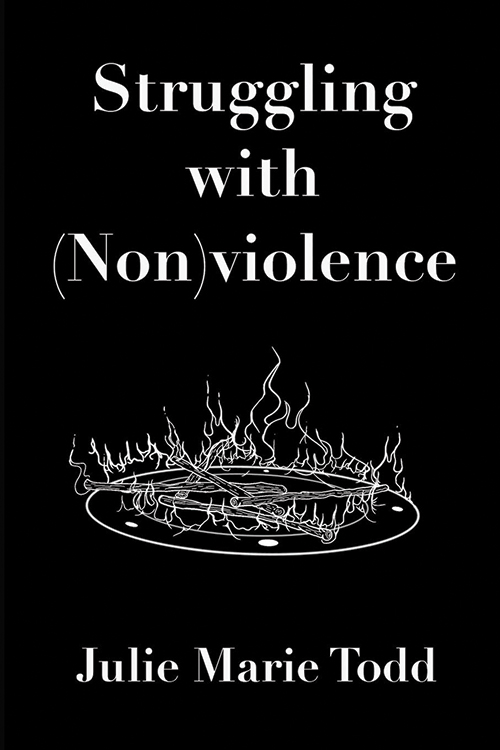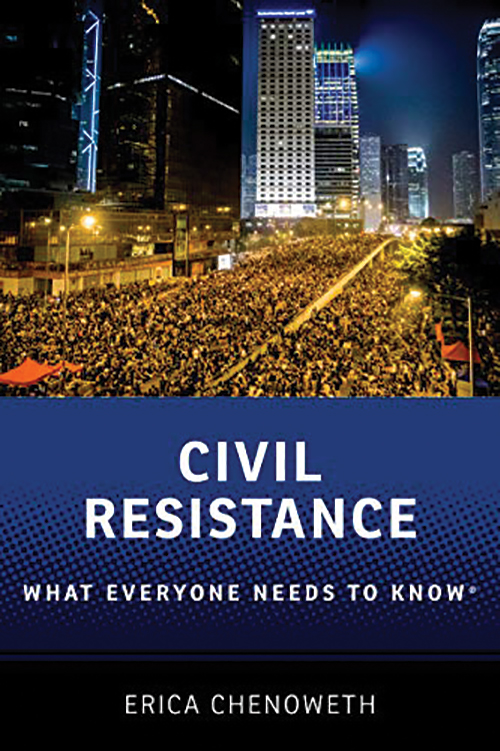
Struggling with (Non)violence
Reviewed by Steve Chase
October 1, 2021
By Julie Marie Todd. In Media Res, 2020. 280 pages. $18.98/paperback.

Civil Resistance: What Everyone Needs to Know
By Erica Chenoweth. Oxford University Press, 2021. 364 pages. $74/hardcover; $18.95/paperback; $10.99/eBook.
Julie Marie Todd grew up in a religious home with White, middle-class parents who were active in the Antiwar and Civil Rights Movements. As she says, “I was born and bred into an activism in which nonviolent protest was assumed” to be the “best form of social change.” In this, she is like many Quakers who have intuitively embraced nonviolence but not yet thought through its potential limitations.
Todd’s outlook changed when she became a graduate student and was pushed to “interrogate” her religious pacifism from “the perspective and interests of marginalized and oppressed people.” This ultimately involved her conducting extensive interviews with experienced activists, including Rita “Bo” Brown, Vincent Harding, Kathy Kelly, Katherine Power, Ward Churchill, Dolores Huerta, Alice Lynd, Sarah Schulman, John Dear, Derrick Jensen, Staughton Lynd, and Akinyele Umoja, who all hold various views about nonviolence. In her book, Todd invites us to join her on this theological journey.
She starts by noting that all her interviewees offered a critique of any easy, middle-class pacifism that stays inside its comfortable bubble, ignores the full weight of structural violence in our society, judgmentally slams oppressed people for engaging in armed self-defense, and doesn’t encourage its adherents to engage in radical nonviolent resistance against oppression. This view reminds me of Quaker activist George Lakey’s insight that “most pacifists do not practice nonviolent resistance.” Todd concludes that such passive pacifists are very far from being faithful to a liberating God.
Many of her interviewees also challenge more active pacifists like Todd who regularly engage in nonviolent protests but downplay giving any serious thought to strategic effectiveness. In one of my favorite chapters, Todd takes on the all-too-common notion that God doesn’t call us to be effective at social change, only to act as moral witnesses against oppression and social evil. She concludes—wisely, I think—that this stance also misses the mark. Effectiveness matters if we want to serve as God’s hands in the healing and repair of the world.
Even more challenging, some of Todd’s interviewees urge nonviolent activists to engage more humbly with the possibility that, in some cases, adding violent approaches to social movement efforts, or at least armed self-defense, might be needed in order to protect people and win real victories for justice. The reasons varied for different people, and she lays out each person’s reasoning carefully. This opens up an important line of reflection. Unfortunately, Todd does not deepen the dialogue by discussing the growing body of empirical evidence on the relative effectiveness of nonviolent resistance compared to violent resistance under various conditions. This surprising omission is a missed opportunity that undercuts the ultimate strength of her otherwise valuable book.
Luckily, Erica Chenoweth has written a new book about what Gandhi termed “civil resistance” and goes on to discuss the best evidence we have on the relative effectiveness of civil resistance compared to armed struggle—and how we might increase the effectiveness of civil resistance movements in the future. It makes for an eye-opening and compelling read. I particularly like how Chenoweth begins their book by sharing how they “evolved from being a detached skeptic of civil resistance to becoming an invested participant in nonviolent movements.”
Unlike Todd, Chenoweth grew up assuming “that violence is the only way to seriously contest power—and that violence often pays.” Like Todd, Chenoweth’s assumptions were challenged when they got to grad school. In 2006, Chenoweth attended a workshop organized by the International Center on Nonviolent Conflict. The ICNC speakers and the workshop readings did not make a moral case for nonviolence. They instead focused on actual case studies of nonviolent resistance campaigns where organized people’s movements had successfully overthrown violent and entrenched dictators and foreign occupiers without relying on political violence or armed struggle. While they found these specific cases interesting, Chenoweth still could not agree to ICNC’s working assumption that “civil resistance was as effective or even more effective than armed struggle in achieving major political concessions.”
Chenoweth spoke out and named several civil resistance campaigns that had failed and many armed struggle campaigns that had succeeded. They argued that the matter couldn’t be decided by only looking at a few select cases of nonviolent successes. Maria Stephan, then an ICNC staffer, responded by challenging Chenoweth to come up with a research program to test their different assumptions about the superior effectiveness of civil resistance or armed struggle when facing brutal, authoritarian regimes. Intrigued, Chenoweth agreed. They teamed up, did an exhaustive historical search from 1900 to 2006, and found 323 cases of major popular resistance campaigns around the world for such “maximalist” goals. They then coded the cases for many factors and ran the first-ever statistical study of the comparative effectiveness of civil resistance. After running the numbers, Chenoweth “was shocked.” It turned out that the following was true:
- Campaigns that relied on civil resistance strategies were twice as successful as campaigns relying on armed struggle in overthrowing their repressive authoritarian opponents.
- Successful civil resistance campaigns took an average of three years to win, while successful armed struggles took an average of nine years.
- Civil resistance campaigns were also significantly better at limiting the intensity of repression and the numbers of civilian casualties than armed struggle campaigns.
- And very importantly, over half of the successful civil resistance transitions led to democratic outcomes five years later, but only 6 percent of the successful armed struggle campaigns ended in achieving democratic outcomes in the same time frame.
In the ten years since the publication of Chenoweth’s and Stephan’s resulting book, Why Civil Resistance Works, the social science study of civil resistance has exploded. The newer studies also demonstrate strong evidence for the conclusion that “civil resistance is a realistic and more effective alternative to violent resistance in most settings.” Chenoweth’s newest book, Civil Resistance, is not written for academics, however. It is written for concerned citizens, activists, and organizers who want usable information to sharpen their strategic understanding of this form of struggle.
Using an accessible question-and-answer format, Chenoweth introduces the concept and historic application of civil resistance campaigns, goes on to outline the basics of how successful civil resisters understand power and how they use a diverse array of tactics beyond just nonviolent protest to win. They also discuss the ins-and-outs of how nonviolent movements often expand popular participation, limit the severity of violent repression by oppressive powerholders, and increase defections among the regimes’ supporters better than armed struggle. Chenoweth also tackles the common disagreements between a majority of nonviolent resisters and a smaller violent flank that thinks the movement needs to engage in unarmed violence or switch to armed struggle in order to win. Finally, Chenoweth looks at how we might learn from the strengths and weaknesses of historic civil resistance movements to increase the effectiveness of our organizing today.
I think Chenoweth has admirably achieved their goal “to make people who read this book feel more equipped, prepared, and empowered to make a difference in the global fight for justice.”
Steve Chase is a member of Friends Meeting of Washington (D.C.) and the author of the Pendle Hill pamphlet Revelation and Revolution: Answering the Call to Radical Faithfulness and the QuakerPress of FGC book Letters to a Fellow Seeker: A Short Introduction to the Quaker Way.


